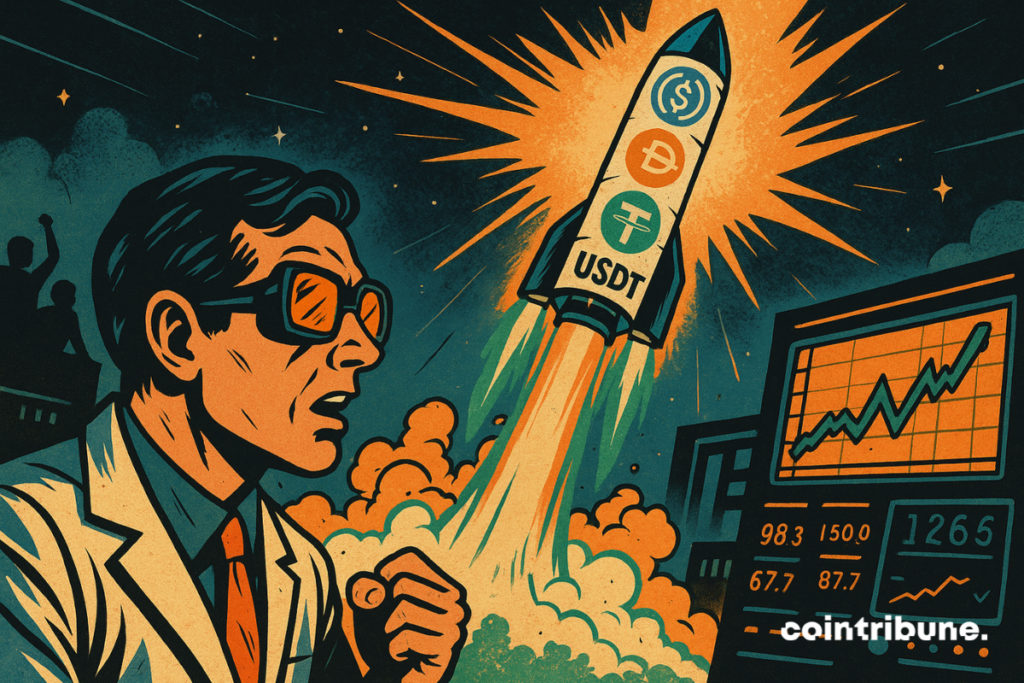Stablecoins Set A New Record
While altcoins still struggle to compete with the rise that Bitcoin has experienced in recent months, stablecoins have reached a new record by surpassing $250 billion in capitalization for the first time. All analysts now agree that a regulatory clarification on these crypto-assets is necessary to reach new levels.

In brief
- Stablecoins now occupy a central place in decentralized finance.
- They come in several categories, each with its own specifics.
- Their rapid expansion demands urgent regulatory clarifications.
Stablecoins, the new champions of decentralized finance
Eleven years after the appearance of Tether’s USDT on Omni, the first Layer 2 solution on the Bitcoin network, stablecoins have crossed the threshold of $250 billion in capitalization, notably thanks to the growth of Real World Assets and their use in international transfers. These stablecoins are mainly present on Ethereum (50% of the stablecoin market), where they are invested in decentralized finance applications, and on Tron (30%) for monetary transfers. With such capitalization, they become, alongside Bitcoin, an indispensable engine of the crypto market.
Crossing $250 billion marks a turning point. Stablecoins are no longer experimental, they’re essential.
Hank Huang, CEO of Kronos Research
Dollar-backed stablecoins dominate this market overwhelmingly, with a capitalization of $245 billion out of a total $250 billion, including $153 billion for USDT and $60 billion for USDC. Here, we see that neither the euro nor the yuan manage to carve out a real place in this stablecoin market. The European Union and China have chosen the path of Central Bank Digital Currencies, which partly explains this retreat from the dollar.
The different categories of stablecoins
To understand the need to clarify regulation on stablecoins, it is necessary to review the different categories of these crypto-assets. We can distinguish centralized stablecoins (such as USDT) and decentralized stablecoins (such as DAI). Centralized stablecoins can track the underlying asset’s price (for example, the dollar) thanks to reserves in dollars or Treasury bonds. Tether’s USDT and Circle’s USDC dominate this category. This category requires the most regulation since it is necessary to guarantee investors that each digital unit is backed by an equivalent value in reserve.
On the side of decentralized stablecoins, the question arises of the mechanism that ensures price stability. The most used mechanism now is collateralization. For example, MakerDAO’s DAI uses several cryptocurrencies to ensure the stability of its price (ETH, BTC, but also USDC). The other mechanism is an algorithmic model that was used by Terra’s UST. An algorithm stabilized its price by varying the amount of LUNA according to UST’s capitalization. However, this mechanism was abandoned after the failure of the algorithm, which caused UST’s price to drop by more than 90%.
Ethena’s USDe is a compromise between these two mechanisms. It indeed ensures its stability through a delta-neutral strategy. A short position offsets the volatility of collateral assets in the opposite direction. This mechanism helps keep the capital that guarantees its price balanced.
The growth of stablecoins demands regulatory clarification
Since his election, Donald Trump has clearly stated his refusal of a Central Bank Digital Currency. On the contrary, the promotion of the dollar will be driven by the growth of centralized stablecoins, which will need to build increasingly large dollar reserves to guarantee the value of these crypto-assets. The U.S. Senate has therefore formulated a legal framework for these assets with the GENIUS Act (Guiding and Establishing National Innovation for US Stablecoins). This text requires an annual audit of stablecoins and provisions for foreign issuers. Other regions of the world are also implementing regulations for these assets. For example, Hong Kong established a license on May 21 for companies wishing to issue a stablecoin.
These regulations will allow major finance companies to establish themselves sustainably in decentralized finance. For now, only BlackRock, through its tokenized fund BUIDL, has firmly established itself in this new market. Other companies, such as JPMorgan or Bank of America, have already indicated that they plan to release their own stablecoin soon. Currently, the volume of decentralized exchanges accounts for only 25% of cryptocurrency trading volume. Decentralized finance thus has a very large growth potential, and stablecoin issuers want to position themselves to reap the benefits of this growth.
Long overlooked and considered simply as a tool, stablecoins have become an essential element of DeFi. Indispensable for investing in Real World Assets or for setting the price of volatile crypto-assets, their growth remains, for now, one of the drivers of the crypto market, even though the momentum around DeFi on Bitcoin has shown mixed developments this year.
Maximize your Cointribune experience with our "Read to Earn" program! For every article you read, earn points and access exclusive rewards. Sign up now and start earning benefits.
Passionné par l’histoire du Web3, je m’efforce de rendre cette nouvelle ère numérique plus compréhensible grâce à mes articles et à ma thèse de doctorat en cours sur le sujet.
The views, thoughts, and opinions expressed in this article belong solely to the author, and should not be taken as investment advice. Do your own research before taking any investment decisions.